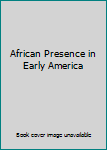African Presence in Early America
No Synopsis Available.
Format:Print on Demand
Language:English
ISBN:0887387152
Release Date:January 1987
Publisher:Transaction Publishers
Weight:0.99 lbs.
Customer Reviews
3 ratings
Careful research and profound evidence
Published by Thriftbooks.com User , 16 years ago
Deeper than just pictures, so save the slideshow! This volume presents what is presently known about the links between Africa and America before the age of Columbus. It makes a convincing case for pre-Columbian contacts between Africa and America before the era of the slave trade. The contributors draw upon the evidence of cultures in private collections and findings from excavations, and evidence of ancient African mathematics, astronomy, map-making, scripts, navigations, trade routes, pyramidal structures, linguistic connections, and technological and ritual complexes. The volume is profusely illustrated. Many readers will find the evidence presented here startling. Ivan Van Sertima is professor of African studies at Rutgers University. He has been visiting professor at Princeton University and lectured at more than one hundred colleges and universities. Professor Ivan Van Sertima's pioneering work in linguistics and anthropology has appeared in numerous scholarly journals. He edits the Journal of African Civilizations, which has greatly changed the way in which African history and culture are taught and studied. In 1983 he edited a book titled Blacks in Science: Ancient and Modern. He also treated that topic in his contribution to the volume African Renaissance, published in 1999 as a record of the conference held in Johannesburg in September 1998 on the theme of the African Renaissance. His article (pp. 305-330) is titled "The Lost Sciences of Africa: An Overview". In it he presents early African advances in metallurgy, astronomy, mathematics, architecture, engineering, agriculture, navigation, medicine and writing. He notes that such higher learning, in Africa as elsewhere, was the preserve of elites in the centers of civilizations, rendering them very vulnerable in the event (as happened in Africa) of the destruction of those centers. Some of his works include Blacks in Science, Nile Valley Civilizations, African Presence in Early America, Black Women in Antiquity, Egypt Revisited, Egypt: Child of Africa, African Presence in Early Europe, Golden Age of the Moor, African Presence in the Art of the Americas, Great Black Leaders, Great African Thinkers (co-edited with Larry Obadele Williams), and African Presence in Early Asia (co-edited with Professor Runoko Rashidi). In 1998 Transaction Press produced produced Van Sertima's Early America Revisited, the definitive statement on the subject.
Prior falsifications need common sense solutions
Published by Thriftbooks.com User , 17 years ago
I've often wondered if (why) people deny that the Australian "aboriginals" were African or of African ancestry. (Are they European, of Chinese extraction, Arabs? or just created from a vacuum?) If this is true and they are of African descent, and since they have been in Australia for over 30,000 years, what makes folks think that these same phenotype Africans couldn't have lived in North and South America, even before the so called "Olmecs" and Africans were all over the globe.... But that doesn't fit the European cultural-political purpose and he who has the gold (resources and institutions) writes the history.
Needs More Debates.
Published by Thriftbooks.com User , 22 years ago
I found this book and the subject interesting when I first read it,which is why I first gave it four stars. After reading it I eventually came across critics of this book. They did raise some interesting and obvious counters to many of Van Sertima's claims,such as,why didn't Van Sertima seriously consider that the Olmec heads were probably the faces of Indians in Mexico and not those of Egyptian/Nubians? Do the Olmec heads look African at first glance? Yes, but when compared to the faces of Mexican area Indians,there's also a similarity between them and the Olmecs stone heads. Also, Van Sertima uses the seven braids on the back of one of the Olmec heads as proof of their Africanism,but you will have a hard time finding an ancient Egyptian or Nubian match for this. Most paintings and sculptures of Egyptians and Nubians show them with full headed braid styles,and not with just seven braids. So far no Olmecs heads have been found with a full headed braid style like the Egyptians and Nubians. As far as Alexander Von Wuthenau's collection of terra cottas potraying African faces. I've read that Von Wuthenau's terra cottas have been declared fakes by pre-Colombian experts because they weren't excuvated from any controlled archeological sites. So I guess that baically means that no one is exactly sure where in Mexico Alexander Von Wuthenau got his terra cotta figures. I'd be interested in hearing Van Sertima's response to the Von Wuthenau collection being declared fakes. These and other counters to Van Sertiam's claims are why I feel this topic definitly needs to be debated more.






